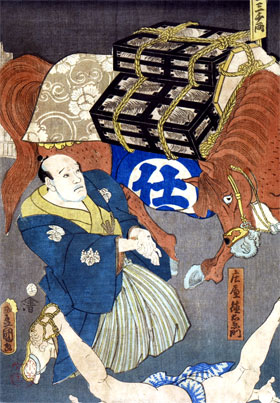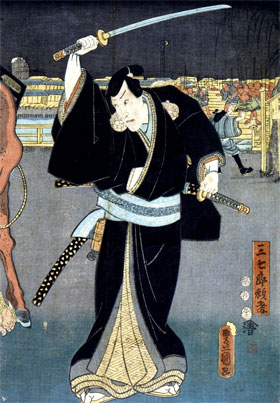| UMAGIRI |
| Play titles | Keisei Haru no Tori Sanzen Ry˘ Kogane no Kurairi Sanzen Ry˘ Haru no Komahiki |
| Common title | Umagiri |
| Authors | Tatsuoka Mansaku (tatesakusha) Chikamatsu Tokus˘, Nagawa Shimesuke I (sakusha) |
| History |
Tatsuoka Mansaku's drama "Keisei Haru no Tori" was premiered in the 1st lunar month of 1794, in ďsaka at the Kado no Shibai [more details]. It was famous for its "Umagiri" scene in which a young samurai slayed a horseman to steal a horse holding 3000 ry˘ in a wooden chest. The hero of this scene was meant to be Matsudaira Ch˘shichir˘, (most likely) the son of Tokugawa Tadanaga who was forced to commit seppuku by his elder brother Tokugawa Iemitsu, the 3rd Tokugawa Shogun! In order to avoid the strict censorship by the ruling Tokugawa Shogunate, the playwrights used the Taik˘ki sekai with Matsudaira Ch˘shichir˘ being turned into Oda Sanshichir˘ Nobutaka, the son of Oda Nobunaga (Oda Harunaga in the drama). In October 1898, the "Umagiri" scene was turned into an independent drama which was entitled "Sanzen Ry˘ Kogane no Kurairi" and which was staged in T˘ky˘ at the Miyatoza. In this drama, the hero was finally Matsudaira Ch˘shichir˘! It was played by Ichimura Kakitsu VI. Later, this role became an important role of the Kataoka clan and it was included in the Kataoka Jűnishű collection of roles. In January 2014, there was the premiere at the National Theatre of "Sanzen Ry˘ Haru no Komahiki", a revival with new elements of Tatsuoka Mansaku's 1794 drama "Keisei Haru no Tori" in which the hero was Oda Sanshichir˘ Nobutaka, not Matsudaira Ch˘shichir˘ [more details]. |
| Structure |
The original drama "Keisei Haru no Tori" was in 7 acts, divided into 23 scenes. "Sanzen Ry˘ Haru no Komahiki" was in 6 acts, divided into 9 scenes. |
| Key words |
Kataoka Jűnishű Kii Mashiba Hisayoshi Matsudaira Ch˘shichir˘ Oda Harunaga ďsaka-j˘ Ry˘ Seppuku Sh˘ya Tachimawari Tokugawa Iemitsu Tokugawa Tadanaga Umagiri |
| Summary |
The "Umagiri" scene in the original drama "Keisei Haru no Tori" The scene is set at the Yamato Bridge in Sumiyoshi in ďsaka. A group of robbers are fighting against a horseman around his horse, which is carrying a chest containing 3000 ry˘. This money has been donated by Mashiba Hisayoshi to a temple on Mount K˘ya in the Kii province in honor of the first anniversary of the death of the warlord Oda Harunaga. The robbers defeat the horseman and start to lead away the horse and its treasure. Suddenly, coming from out of nowhere, a black-clad man appears on stage and orders them to hand over the 3000 ry˘. The robbers attack him but he kills them all. A group of Hisayoshi's officers appear on stage and discover that the samurai is none other than Oda Harunaga's son Oda Sanshichir˘ Nobutaka. The officers agree that he has the right to take the money away as it was donated to commemorate his father's memory. Nobutaka leaves with the horse and the 3000 ry˘. He will give the money to his loyal friend the lumber wholesaler Tarosuke, who financially sacrificed himself to pay back the heavy debts contracted by Nobutaka because of his life of dissipation in the pleasures quarters. The "Umagiri" scene in "Sanzen Ry˘ Kogane no Kurairi" As the scene opens at the Yamato Bridge in Sumiyoshi in ďsaka, several townspeople are talking about the passing of a horse carrying a big wooden chest containing a large sum of money. There are 3000 ry˘ in the chest and this money is being sent to the ďsaka Castle by Tokugawa Iemitsu, the Lord of Kii. The hero of this scene is Matsudaira Ch˘shichir˘, the son of Tokugawa Tadanaga, the younger brother of Iemitsu. Since the seppuku of his father, the house of Matsudaira has been descending in power, with Tokugawa Iemitsu ascending to supremacy. Ch˘shichir˘ holds a bitter grudge against Iemitsu, who forced his father to commit seppuku. He has frequented the pleasures quarters to comfort his tortured mind, wasting time and money with courtesans. His funds have quickly dwindled. He is now poor and roams the country living like a vagabond. He has heard the rumor about the passing of the 3000 ry˘ of cash belonging to Iemitsu, loaded on horse-back. Matsudaira Ch˘shichir˘, seeing an opportunity to secure the urgently needed money, waits for and accosts the horse and its retinue on the Yamato Bridge. He shouts that this horse and its chest belong to him. Then, he cuts down the horseman with a single slash. The head guard Denkur˘ comes forward. This is followed by a confusing tachimawari and finally Denkur˘ is killed by Ch˘shichir˘. Just then, the sh˘ya Tarosuke, a former servant of Ch˘shichir˘, comes running from the hanamichi and recognizes his former master. A large company of warriors arrive. Tarosuke informs them that the offender is their late Lord's son Matsudaira Ch˘shichir˘. They all sit on the ground and apologize, each announcing his name. They are Nagai Jinzaemon, Hayashi Shinrokur˘, Imai Chűrokur˘, Aoki Sakon, Komabayashi T˘zaemon, Wada Kyűnoshin, Hattori Hy˘bu and Igarashi Shuzen. Ch˘shichir˘ explains to all of them that since his father's death, he has been roaming around the country. Being desperately in need of money, he will keep the 3000 ry˘. They all agree and tell him to use the money for his pleasure. Ch˘shichir˘ hits the horse and is about to move away, opening his fan for the final pose, while the curtain closes the scene. |
 |
 |
|
The actors Nakayama Ichiz˘ and Ichikawa Danjűr˘ VIII playing the roles of the sh˘ya Tokuemon and Oda Sanshichir˘ Nobutaka in the "Umagiri" scene of the drama "Kozotte Kuruwa Mimasu no Datezome", which was staged in the 1st lunar month of 1853 at the Nakamuraza (print made by Utagawa Toyokuni III) |
|
|
|
| Contact | Main | Top | Updates | Actors | Plays | Playwrights | Programs | Links | FAQ | Glossary | Chronology | Illustrations | Prints | Characters | Derivatives | Theaters | Coming soon | News |